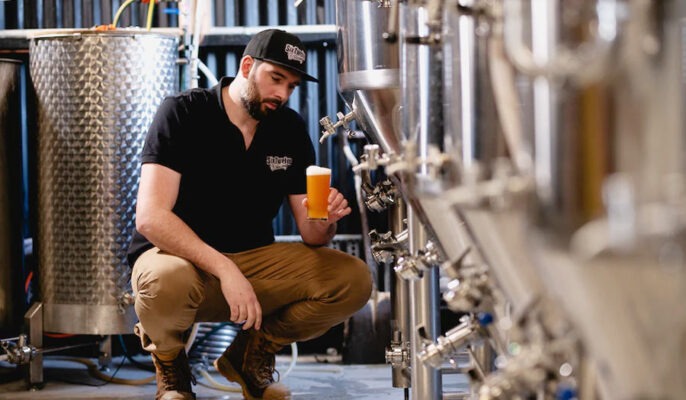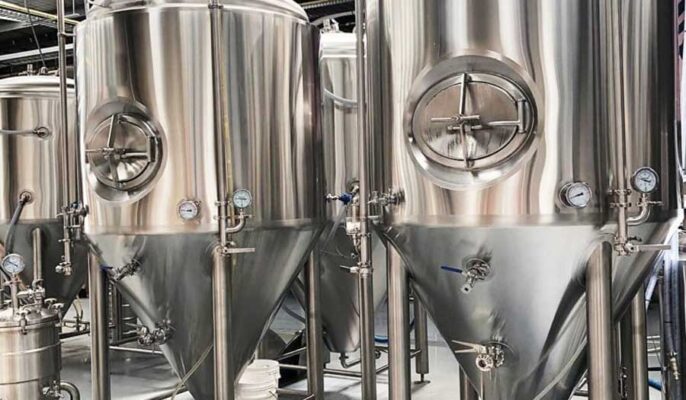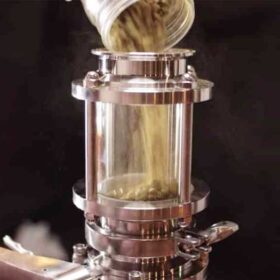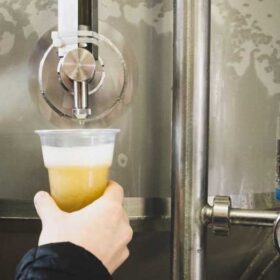Craft beer has witnessed a phenomenal rise in popularity in recent years, with beer enthusiasts seeking unique flavors and artisanal brews. Behind every successful craft brewery lies a range of specialized equipment designed to meet the demands of this ever-growing industry. In this article, we will delve into the world of microbrewery equipment, exploring its various types, essential components, factors to consider when choosing the right equipment, and much more. So, grab a cold one and let’s embark on this journey of microbrewery equipment!
What is Microbrewery Equipment?
Before we dive into the details, it’s essential to understand what microbrewery equipment entails. In simple terms, microbrewery equipment refers to the machinery and tools used in the production of craft beer on a small scale. Unlike large-scale commercial breweries, microbreweries focus on producing limited quantities of beer with an emphasis on quality and experimentation.
Types of Microbrewery Equipment
When setting up a microbrewery, there are various types of equipment that are essential for the brewing process. Here are some of the key types of microbrewery equipment:
- Brewhouse Equipment: The brewhouse is the heart of a microbrewery where the brewing process takes place. It typically includes several components:
- Mash Tun: A vessel where malted grains are mixed with hot water to extract sugars during mashing.
- Brew Kettle: Also known as the boiling kettle, it is used for boiling the wort and adding hops.
- Hot Liquor Tank: It stores hot water used in the brewing process.
- Whirlpool: Used for separating the hot trub (sediment) from the wort after boiling.
- Fermentation Equipment: Fermentation is a crucial step in beer production where yeast converts sugars into alcohol. Fermentation equipment includes:
- Fermenters: Vessels where the wort is fermented and yeast converts sugars into alcohol and carbon dioxide.
- Brite Tanks: Also known as conditioning tanks or maturation tanks, they are used for the secondary fermentation and clarification of beer.
- Wort Cooling and Filtration Equipment: After boiling, the wort needs to be cooled and filtered. This equipment includes:
- Plate Chillers: Heat exchangers that cool the hot wort rapidly.
- Heat Exchangers: Devices that transfer heat from the hot wort to the cold water.
- Filtration Systems: Used to clarify the beer by removing solids, sediment, and haze.
- Cellaring Equipment: Cellaring equipment is used for conditioning and aging the beer after fermentation. It includes:
- Aging Tanks: Vessels where the beer is aged for a specific period to develop desired flavors and aromas.
- Barrels: Used for barrel-aging beers, imparting unique flavors from the wood.
- Kegging Systems: Equipment for kegging the beer, preparing it for distribution or serving.
- Packaging Equipment: Packaging equipment is used for bottling or canning the beer and preparing it for distribution. It includes:
- Bottling Machines: Automated systems for filling and capping bottles.
- Canning Lines: Equipment for filling, sealing, and labeling cans.
- Labeling Systems: Machines that apply labels to bottles or cans.
- Control Systems: Microbreweries often utilize control systems to monitor and control various parameters of the brewing process, such as temperature, pressure, and timing. These systems ensure consistency and precision in beer production.
- Cleaning and Sanitization Equipment: Maintaining cleanliness and hygiene is crucial in the brewing industry. Cleaning and sanitization equipment, including Clean-in-Place (CIP) systems, helps remove contaminants and maintain sanitary conditions in the brewing equipment.
These are some of the main types of microbrewery equipment that brewers utilize to produce high-quality craft beer. Each equipment type serves a specific purpose in the brewing process, and the selection depends on the brewery’s production capacity and specific brewing requirements.

Essential Components of Microbrewery Equipment
Microbrewery equipment consists of various essential components that contribute to the brewing process and overall functionality of the brewery. These components work together to ensure the efficient production of high-quality craft beer. Here are some of the key essential components found in microbrewery equipment:
- Control System: A control system is a vital component that regulates and monitors various parameters throughout the brewing process. It includes sensors, probes, controllers, and software that allow brewers to manage and adjust temperature, pressure, timing, and other critical variables. The control system ensures consistency and precision in the brewing process.
- Pumps: Pumps play a crucial role in moving liquids within the brewing system. They are responsible for transferring wort, beer, cleaning solutions, and other fluids between different vessels and equipment. Pumps are available in various types, including centrifugal pumps and positive displacement pumps, and their selection depends on the specific requirements of the brewing process.
- Heating and Cooling Systems: Heating and cooling systems are essential for maintaining precise temperature control during different stages of the brewing process. These systems include heat exchangers, boilers, chillers, and glycol systems. They enable brewers to heat the brewing water, control the temperature during mashing, cool the wort after boiling, and maintain fermentation temperatures within desired ranges.
- Grain Handling Equipment: Grain handling equipment is crucial for efficiently processing malted grains. This equipment includes grain mills, which crush the malted grains to expose the starches for extraction during mashing, and augers or conveyors, which help transfer the milled grains to the mash tun.
- Cleaning and Sanitization Equipment: Maintaining cleanliness and ensuring proper sanitization of brewing equipment is essential for producing high-quality beer. Cleaning and sanitization equipment includes Clean-in-Place (CIP) systems, which automate the cleaning process by circulating cleaning solutions through the brewing vessels and piping. This helps remove residual contaminants, yeast, and bacteria, ensuring hygienic brewing conditions.
- Fermentation Vessels: Fermentation vessels, such as fermenters and brite tanks, are where the wort undergoes fermentation and conditioning. These vessels are typically made of stainless steel and often equipped with temperature control systems, pressure relief valves, and sanitary fittings to create an optimal environment for yeast activity and beer maturation.
- Packaging Components: Packaging components are essential for the packaging and distribution of the finished beer. They include carbonation systems, filling valves, keg couplers, bottle or can fillers, and labeling systems. These components help package the beer into bottles, cans, or kegs while ensuring proper carbonation and maintaining product quality.
- Valves and Fittings: Valves and fittings are crucial for controlling the flow of liquids and gases within the brewing system. They include ball valves, butterfly valves, sample valves, sight glasses, and sanitary fittings. These components enable brewers to control the movement of fluids during various stages of the brewing process, such as transferring liquids between vessels, controlling flow rates, and taking samples for quality testing.
These are some of the essential components found in microbrewery equipment. Each component plays a critical role in the brewing process, ensuring efficiency, control, and hygiene throughout the production of craft beer. The selection and integration of these components depend on the specific needs and scale of the microbrewery.
Factors to Consider When Choosing Microbrewery Equipment
When choosing microbrewery equipment, several factors should be taken into consideration to ensure the equipment meets your brewing needs and supports the success of your microbrewery. Here are some key factors to consider:
- Production Capacity: Determine the desired production capacity of your microbrewery. Consider the volume of beer you aim to produce, both in terms of batch size and overall annual production. Choose equipment that can handle your projected production volume effectively.
- Quality and Efficiency: Invest in high-quality equipment that is designed for efficient and consistent performance. Look for reputable manufacturers known for their craftsmanship and reliability. Efficient equipment will help you optimize your brewing process, reduce waste, and improve overall productivity.
- Flexibility and Scalability: Consider the flexibility and scalability of the equipment. Evaluate whether the equipment allows for future growth and expansion. Can it accommodate increasing production volumes or the addition of new beer styles? Choosing equipment that offers flexibility and scalability will enable you to adapt to changing market demands and brewery growth.
- Space and Layout: Assess the available space in your brewery and consider the equipment layout. Ensure that the equipment you choose fits within your allocated space and allows for efficient workflow and ease of operation. Consider the accessibility of the equipment for maintenance and cleaning purposes.
- Budget and Cost Analysis: Set a realistic budget for your microbrewery equipment. Consider not only the initial purchase cost but also the long-term cost of ownership, including maintenance, repairs, and utility expenses. Conduct a thorough cost analysis to understand the financial implications and ensure that your equipment investments align with your budget.
- Brewing Style and Complexity: Consider the specific brewing style and complexity of beers you intend to produce. Some equipment may be better suited for specific beer styles or brewing techniques. Ensure that the equipment you choose supports the brewing processes and techniques required for your desired beer profiles.
- Support and Service: Assess the level of support and service offered by equipment manufacturers or suppliers. Consider factors such as warranty, technical assistance, spare parts availability, and after-sales support. Reliable support ensures prompt assistance in case of equipment issues or breakdowns.
- Energy Efficiency and Sustainability: Consider the energy efficiency and sustainability features of the equipment. Energy-efficient equipment can help reduce utility costs and minimize environmental impact. Look for equipment that incorporates features like heat recovery systems, efficient insulation, and water-saving technologies.
- Regulatory Compliance: Ensure that the equipment meets the necessary regulatory standards and complies with local health and safety regulations. Compliance with regulations ensures the safety of your operations and the quality of your beer.
- User-Friendliness and Training: Consider the ease of use and user-friendliness of the equipment. Equipment that is intuitive and user-friendly will streamline your brewing process and reduce the learning curve for your brewing team. Additionally, assess the availability of training resources and support to ensure that your team can effectively operate the equipment.
Key Considerations for Setting Up a Microbrewery
Setting up a microbrewery requires careful planning and consideration. Here are some key considerations to keep in mind:
- Licenses and Permits: Obtain the necessary licenses and permits required by local authorities to operate a brewery. This may include permits for production, distribution, and serving alcohol.
- Location and Space: Choose a suitable location for your microbrewery, considering factors such as accessibility, zoning regulations, and proximity to your target market. Ensure the space is adequately ventilated, has proper drainage, and meets safety standards.
- Recipe Development and Experimentation: Craft beer enthusiasts appreciate innovation and unique flavors. Invest time in developing and refining your beer recipes, allowing room for experimentation and creativity.
- Marketing and Branding: Develop a strong brand identity and marketing strategy to promote your microbrewery. Utilize social media, online platforms, and local events to create awareness and attract customers.
- Staff and Training: Recruit a skilled team of brewers, cellar workers, and sales staff who are passionate about craft beer. Provide ongoing training to enhance their knowledge and skills, ensuring consistent quality in beer production.
By considering these key aspects, you can lay a solid foundation for your microbrewery and increase your chances of success in the competitive craft beer market.
Cost Analysis of Microbrewery Equipment
Starting a microbrewery involves significant financial investment. Here is a cost analysis of key equipment and other expenses to help you plan your budget:
- Brewhouse Equipment: The cost of a brewhouse can vary depending on its size, configuration, and additional features. A small-scale brewhouse suitable for a microbrewery can range from $50,000 to $200,000. This includes the mash tun, brew kettle, hot liquor tank, and whirlpool.
- Fermentation Equipment: Fermentation equipment, including fermenters and brite tanks, can cost between $10,000 and $50,000, depending on their size and specifications. Temperature control systems may require an additional investment of $5,000 to $20,000.
- Wort Cooling and Filtration Equipment: Investing in plate chillers, heat exchangers, and filtration systems can cost around $10,000 to $30,000. These systems play a crucial role in maintaining the clarity and quality of the beer.
- Cellaring Equipment: Cellaring equipment, such as aging tanks, barrels, and kegging systems, may range from $10,000 to $50,000. The cost will depend on the capacity and materials used.
- Packaging Equipment: Packaging equipment, including bottling machines, canning lines, labeling systems, and packaging materials, can vary significantly in cost. A small-scale packaging setup can range from $10,000 to $50,000 or more, depending on the desired output capacity.
In addition to equipment costs, it’s important to consider other expenses, such as:
- Renovation and construction costs for the brewery space
- Utilities, including water, electricity, and gas
- Raw materials, such as malt, hops, yeast, and adjuncts
- Marketing and advertising expenses
- Licensing and permit fees
- Insurance coverage for the brewery and equipment
- Ongoing maintenance and repairs

Benefits of Using High-Quality Microbrewery Equipment
Using high-quality microbrewery equipment offers several benefits for brewers and their craft beer production:
- Consistent Quality: High-quality equipment ensures consistency in the brewing process, resulting in consistent flavor profiles and beer quality. Precise temperature control, efficient filtration, and reliable fermentation contribute to the overall consistency of the final product.
- Enhanced Efficiency and Productivity: High-quality equipment is designed to optimize efficiency and productivity. Advanced technology, such as automated controls and efficient heat transfer systems, allows brewers to streamline their operations, reduce manual labor, and increase output without compromising on quality.
- Improved Control and Flexibility: Top-notch equipment provides brewers with better control over various parameters, such as temperature, pressure, and flow rates. This level of control enables them to fine-tune their brewing processes, experiment with different recipes, and achieve desired flavors and aromas with precision.
- Durability and Longevity: Investing in durable, well-built equipment ensures longevity and reduces the risk of breakdowns or costly repairs. High-quality materials and craftsmanship contribute to the reliability and robustness of the equipment, allowing brewers to focus on their craft rather than equipment maintenance.
- Safety and Hygiene: Premium microbrewery equipment is designed with safety and hygiene in mind. It incorporates features such as sanitary fittings, easy cleaning access, and adherence to industry standards for food-grade materials. This helps maintain a clean, sanitary brewing environment and minimizes the risk of contamination.
By using high-quality microbrewery equipment, brewers can elevate their craft, produce exceptional beers, and build a solid foundation for long-term success in the competitive craft beer market.
Challenges and Solutions in Microbrewery Equipment
Microbrewery equipment comes with its own set of challenges. However, with careful planning and proactive measures, these challenges can be overcome. Here are some common challenges in microbrewery equipment and potential solutions:
- Cost Constraints: Investing in microbrewery equipment can be a significant financial burden, especially for small-scale or startup breweries. To overcome this challenge, brewers can consider leasing options, seek financing partnerships, or opt for used equipment that meets their quality standards.
- Maintenance and Technical Expertise: Maintaining and troubleshooting complex brewing equipment requires technical expertise. Brewers can address this challenge by investing in training programs for their staff or partnering with equipment suppliers that provide comprehensive support and maintenance services. Regular equipment inspections and preventive maintenance can help identify and address issues before they become costly problems.
- Quality Control and Consistency: Maintaining consistent quality across batches can be challenging, especially for smaller breweries. Implementing strict quality control protocols, investing in automation and monitoring systems, and conducting regular sensory evaluations can help ensure consistency in taste, aroma, and overall beer quality. Standardizing processes and documenting recipes and brewing parameters can also contribute to consistent results.
- Scaling Production: As breweries grow and demand increases, scaling up production while maintaining quality can be a challenge. Brewers should plan for scalability from the start, ensuring that their equipment and infrastructure can handle increased volumes. Collaboration with experienced brewing consultants can provide valuable insights and assistance during this process.
- Regulatory Compliance: Microbreweries need to adhere to various regulatory requirements, including permits, licensing, health and safety standards, and labeling regulations. Staying informed about local, regional, and national regulations, and working closely with legal and compliance experts, helps ensure compliance and avoid potential legal issues.
By proactively addressing these challenges and seeking appropriate solutions, brewers can optimize their microbrewery equipment’s performance, ensure consistent quality, and achieve sustainable growth in the competitive craft beer industry.







Photoshop Crack